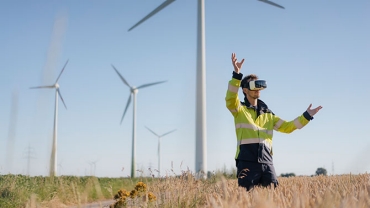
Setting the scene: current fiscal incentives
Below are the main ‘green’ fiscal instruments currently in place in the EU. In addition, there are taxes and subsidies implemented at the national level in each Member State.



Taxes and emission pricing
- The EU Emissions Trading System (ETS)
- The EU Energy Tax Directive (ETD)
- Carbon Border Adjustment Mechanism (CBAM)
The EU Emissions Trading System (ETS)
The EU ETS is the main instrument for pricing greenhouse gas (GHG) emissions for the EU to reach its climate targets. It is a cap-and-trade system in which governments set an allowable total amount of emissions (“cap”) over a certain period of time and issue tradable emission permits (“trade”).
The tradable emission rights have been gradually reduced. In 2018 the ETS was revised to better support the EU’s (then) -40% emissions reduction target. The Market Stability Reserve (MSR) was also introduced in order to address market imbalances and improve the ETS’s resilience to sudden demand shocks. It does so by reducing the surplus of emission credits available thereby avoiding sharp price drops.1
The EU recently tightened its GHG emissions reduction target again to -55% by 2030. To meet this new target, the pace of reduction of tradable emission rights would need to increase. Furthermore, the scope of the ETS system will likely also be broadened to cover a wider range of industries. All of this should lead to higher emission prices over time and should create more incentives for green investments. The legislative proposals related to this are expected mid-2021.
1The MSR automatically takes a portion of ETS allowances off the market and puts them into the reserve if there is a surplus exceeding a certain threshold. In the opposite scenario, allowances would be returned to the market.
The EU Energy Tax Directive (ETD)
The ETD was adopted in 2003 and sets the minimum tax rates on electricity, motor, aviation and most heating fuels for all EU Member States. In 2019 the European Commission suggested a revision of the framework in order to consider changes on the EU energy market and in EU legislative frameworks, and to correct the ETD’s misalignment with new technologies. As all national energy tax laws within the EU need to align with the ETD, there is currently a standstill awaiting a broader reform of energy taxes in the EU. Member States are waiting for the new revised ETD, which will serve as a starting point for updating national energy tax laws.
Several options are considered for the revision such as: setting minimum tax rates based on the energy source and on greenhouse gas emissions, harmonising tax bases, making a sectoral tax differentiation and extending scope of the ETD. PwC recently provided its input on those matters during the European Commission’s public consultation. The main points PwC made were to harmonise and simplify energy taxation within the Single Market overall. Streamlining the highly complex patchwork of national rules would make it easier for companies to comply with their tax obligations. Consistency between the ETD and the ETS should also be ensured.
Carbon Border Adjustment Mechanism (CBAM)
The Carbon Border Adjustment Mechanism (CBAM) was proposed by the European Commission as part of the Green Deal. It will be a tool to prevent carbon leakage2 by placing a tax on goods imported into the EU based on their greenhouse gas content. The CBAM would also protect EU companies from competition from regions outside of the EU where GHG emissions are higher, and would create a level playing field for companies in carbon intensive sectors in Europe. However, the introduction of a CBAM could increase trade tensions between the EU and other trade blocks.
The legislative proposal by the Commission is scheduled for the second quarter of 2021. An Impact Assessment was carried out by the Commission in 2020 on which PwC provided its view. The main points PwC made related to the choice of policy instrument, the potential risk of double pricing of emissions, as well as the relation between the ETD, the ETS and the CBAM.
2Carbon leakage refers to when a company transfers production to a country with less stringent regulation on GHG emissions. The emissions are avoided in the country of origin (Europe) but still emitted in another territory. This does not reduce global emissions overall.



Subsidies and funding
- Horizon Europe
- The Innovation Fund
- The Connecting Europe Facility (CEF)
- Important Projects of Common European Interest (IPCEI)
- European Investment Bank loans and funding
Horizon Europe
Horizon Europe is the EU’s €95.5 bn research and innovation programme (replacing Horizon 2020) that aims to deliver solutions to some of Europe’s most pressing future challenges, including climate change.
It is designed to bring nascent technologies to the next phase and to bring them to the market (rather than being a fund for fundamental research). In order to qualify, research projects need to be public-private collaborations and involve three different EU Member States in the different stages of the project. Project funding is normally two to four years and the average amount of funding is from €5m to €25m. The average funding rate is expected to be 40-70 percent for private companies, and 100% for non-profit organisations (knowledge institutes and academia).
The Innovation Fund
The Innovation Fund is a funding programme for large scale demonstration projects for innovative low emission technologies. It supports innovation in energy efficiency, renewables, energy storage, as well as carbon capture, usage and storage. It is funded by revenues from the EU ETS which is expected to be around €10 bn for the period 2020-2030. The first tender is in progress and will provide funding of €1bn.
The Connecting Europe Facility (CEF)
The Connecting Europe Facility (CEF) provides EU grants for cross border projects that tackle bottlenecks in energy, transport and digital infrastructure. One of the key priorities of the CEF is to enable and strengthen synergies between these three sectors. It provides funding to projects that are high in technology readiness, i.e. that are in a demonstration or deployment phase. In addition to grants, the CEF offers financial support to projects through guarantees and project bonds.
Important Projects of Common European Interest (IPCEI)
The IPCEI vehicle allows individual EU Member States to support specific projects or technologies with additional funding within the EU State Aid Framework. An advantage of IPCEI is that costs for first industrial deployment, i.e. between pilot and start of mass production,3 can be eligible for funding. This allows for the development of new highly innovative products or production processes.
To qualify as an IPCEI, projects must contribute to EU objective(s) and have a significant impact on competitiveness, sustainability, or value creation across the EU. Projects must also involve more than one Member State and be co-financed by the beneficiary.
3First industrial deployment refers to the upscaling of pilot facilities, or to the first-in-kind equipment and facilities which cover the steps subsequent to the pilot phase including the testing phase but cannot include mass production or commercial activities.
European Investment Bank loans and funding
The EIB provides green financing for investment projects at all levels of technology readiness.4 There is a vast range of products available for both private and public investors to address specific investment needs and market gaps.
4Technology readiness levels (TRLs) are a method for estimating the maturity of technologies during the acquisition phase of a programme. It was developed by NASA in the 1970s.
A good first step, but adjustments are needed
The EU ETS remains the key policy tool for pricing greenhouse gas (GHG) emissions within the EU. Together with the European Tax Directive and the Carbon Border Adjustment Mechanism, the ETS forms an overall framework aiming to ensure ‘one emission price’ for all EU Member States. While the framework (consisting of the EU ETS and the ETD) has proven efficient and effective in the past, a revision will be needed in order to make sure that it remains aligned with the climate objectives of the EU. This has been planned by the European Commission.
The current emission price is not pushing green investments hard enough for the EU to meet its accelerated climate ambitions. New technologies have come to the market and the highly complex patchwork of national energy tax rules and exemptions is not aligned with the European energy market as it looks today. Any update to this framework should be carried out with a view to creating an efficient and effective overall framework for emission pricing across the EU.
Furthermore, diverging ambitions to reduce GHG emissions, both at the global level as well as between EU Member States, pose a realistic risk of carbon leakage. If taxation on GHG differs within the EU, production will move to those parts of the EU where emitting GHG is cheaper. We have set this out in our Green Deal Monitor on the Dutch CO2 tax. While taking into account the different starting points of the Member States in the energy transition, common principles for taxing energy consumption and GHG emissions are necessary for further integration of the Single Market.
Likewise, without a global framework - or a carbon border adjustment tax to compensate for the absence of such a global framework - production may move outside of the EU and we could see a decline in the competitiveness of the European economy.
The European Commission should use the current momentum - the urgency of a green recovery after Covid-19 and the current Green Deal enthusiasm - to speed up the legislative process, as the current timelines do not express the adequate sense of urgency. As scientific research would support, the need to make the EU greener is urgent.
The funds that are (becoming) available for investments that can help the EU meet the objectives of the Green Deal come mainly from existing EU programmes. As things stand now, revenues from the ETS are not fully linked to the funds spent. Linking revenues to spending could make more funds available to realise the green transition.
What more can be done?
As we have seen, the EU has taken several steps to steer investments in a direction to meet its Green Deal targets. Those are welcome first steps, but there are a few additional measures, as well as aspects of its current measures, that the EU could consider in order to increase the Green Deal’s chances of success.
As a first, the EU could use the revenues of the EU ETS to help businesses make a green transition, and to fund climate adaptation infrastructure as well as R&D for climate change mitigation technologies. National governments could do the same with the revenues of energy taxes. Additionally, national governments could introduce tax reliefs for innovative low(er) carbon technologies during a well defined transition period, for example for biofuel or hydrogen.5
Secondly, the EU could expand the EU ETS so that it would also include emissions from non-industrial uses of fossil fuels, such as for example aviation. This would lead to a fairer pricing of products and services. This in turns could help achieve a single, more realistic, price for greenhouse gas emissions.
Thirdly, the EU would need to engage constructively with trade partners in order to find a balance between protecting European industry during the transition to a low carbon economy, and avoiding retaliations by trade partners. Retaliations by trade partners could damage the EU’s exporting industries and undermine citizens’ commitment to the Green Deal. Ensuring sufficient, persistent and genuine commitment by a large share of EU citizens will be paramount to achieving the objectives of the Green Deal.
5The EU could provide examples and/or guidelines for how to design these incentives in order to avoid (large) differences in policy between Member States while also complying with EU state aid rules.

Key takeaways for organisations
- The price of greenhouse gas emissions (GHG) in the EU is expected to increase in the years ahead and companies need to take this into account when making investment decisions and setting an investment agenda (type, volume, timing and innovation).
- Products imported into the EU from non-EU countries will likely be subject to a carbon border tax in the future. Companies that import carbon intensive products into the EU should start collecting data on the GHG footprint of imported products.
- Various EU funds are available to companies and organisations in order to help realise the EU’s Green Deal ambitions. These should be explored for companies to make the right strategy and investment decisions.
- Policies, at the EU and Member State level alike, may change over time. It is important for organisations to keep monitoring the policy landscape while keeping the ambition to reach net zero in mind.
Contact us

Energy - Utilities - Resources Industry, Tax, Partner, PwC Netherlands
Tel: +31 (0)65 154 18 97

Partner, Energy transition and sustainable energy, PwC Netherlands
Tel: +31 (0)65 160 08 61



















